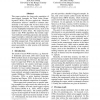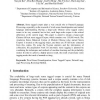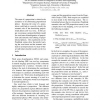49 search results - page 8 / 10 » Hungarian Word-Sense Disambiguated Corpus |
EMNLP
2004
13 years 8 months ago
2004
This paper explores the large-scale acquisition of sense-tagged examples for Word Sense Disambiguation (WSD). We have applied the "WordNet monosemous relatives" method t...
ACTAC
2006
13 years 7 months ago
2006
In this paper we introduce a statistical Named Entity recognizer (NER) system for the Hungarian language. We examined three methods for identifying and disambiguating proper nouns...
CIARP
2004
Springer
14 years 24 days ago
2004
Springer
We present a method for extracting selectional preferences of verbs from unannotated text. These selectional preferences are linked to an ontology (e.g. the hypernym relations foun...
LKR
2008
13 years 8 months ago
2008
Sense tagged corpus plays a very crucial role to Natural Language Processing, especially on the research of word sense disambiguation and natural language understanding. Having a l...
EMNLP
2009
13 years 5 months ago
2009
The sense of a preposition is related to the semantics of its dominating prepositional phrase. Knowing the sense of a preposition could help to correctly classify the semantic rol...



